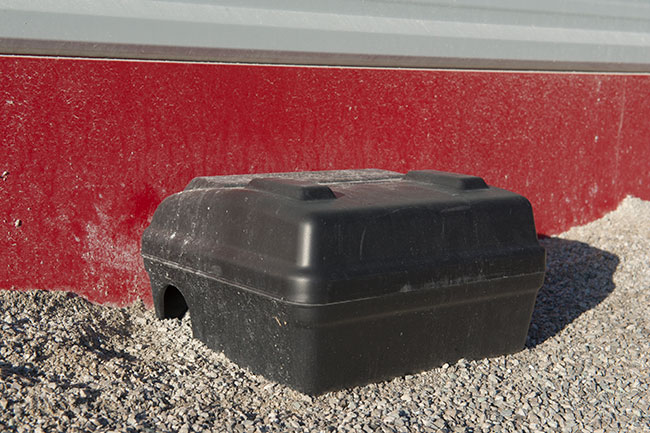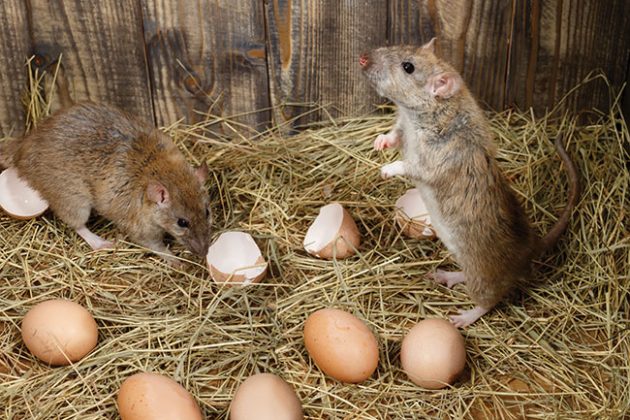
Pest Control: Ratting out rodents
By Alice Sinia
Features Barn ManagementTips to help prevent rats and mice from entering your barn.
 A proactive, preventive approach to pest management is essential.
A proactive, preventive approach to pest management is essential. Rodents can easily ruffle feathers in any poultry farm. These varmints not only disturb and agitate fowl but can also cause expensive damage to the property and transmit harmful diseases to birds and humans. Rodents can quickly become a nuisance to any poultry farming facility, so catching a rodent problem early on will help prevent a larger population from wreaking havoc.
Like humans, rodents seek shelter indoors as temperatures drop in the winter months, and as food becomes scarce outdoors, they seek food and protection in man-made structures. To protect facilities from turning into rodents’ next nesting spot, it is important to shield any space from these pests before they settle in for the winter.
Understanding how to identify rodents’ entryways and harbourage points – and eliminating other conditions that attract them – can help prevent rats and mice from entering a facility.
Structural deficiencies
Rodents do not need much room to slip inside undetected. So, it is important to pay close attention to any structural deficiencies that may allow these pests to sneak in.
Rats can fit through holes the size of a quarter, while mice are able to fit through gaps as small as a dime. As you inspect facilities and building exteriors for pest activity, keep an eye out for any cracks, gaps and crevices that can help rodents escape the cold.
Wear-and-tear openings around foundations, utility lines, vents, roof vents and walls provide major entry points for rodents. Landscaping may also allow rodents an easier entrance into the building. Overgrown tree branches and shrubs provide a bridge onto walls and rooftops, so be sure to trim foliage back away from the building as well.
Installing a gravel barrier can also help prevent rodents from reaching building exteriors because the gravel eliminates burrowing grounds and shelter provided by branches and shrubbery. Experts advise having this barrier be at least 60 cm wide to optimize its effectiveness in preventing rodent activity.
Rodent attractors
In addition to munching on and hiding in any foliage around buildings, rodents are known to feast on spilled grains from feed bins. Inspect feeders for any breaks or cracks that allow mice and rats an all-access pass to their next meal. Replacing any damaged bins can discourage these pests from encroaching on the facility.
Birds’ perches and coops provide rodents with plenty of shelter that allows them to go undetected for a prolonged period of time. Old equipment, machinery and other covered, sheltered areas can also act as the ideal spot for a rodent to burrow.
Check under equipment for any litter that can prevent pests from being discovered and monitor cluttered areas that could harbour rodents. Water is also a strong attractor and provides nesting resources for rodents, so be sure to keep areas dry and remove standing water areas.
Heating lamps are often used to warm up fowl while they are roosting in their perches. While this heat is necessary to keep birds safe and comfortable, it can also attract rodents attempting to escape winter weather.
Pay close attention to areas where heaters or lamps are present and keep an eye out for signs of a potential rodent infestation to identify areas where additional monitoring is needed. These key indicators include droppings and urine stains, grease marks along baseboards and gnaw marks on wiring, walls, feed containers and other materials.

Rodents are known to carry and transmit a variety of diseases, viruses and other illnesses that they can transmit to humans and poultry alike. tenra/iStock / Getty Images Plus/Getty Images
Rodent risks
Rodents are known to carry and transmit a variety of diseases, viruses and other illnesses that they can transmit to humans and poultry alike. As mice and rats roam around facilities, they leave behind droppings, urine and blood that can contaminate areas on the property.
To limit birds’ and employees’ exposure to these rodent souvenirs, implement a facility maintenance schedule to remove and sanitize any rodent remnants that could infect the facility.
Rodent-borne illnesses aren’t the only contaminants rodents leave behind. These pests can also bring other parasitic pests like mites and fleas into the building. Mites and fleas, while small in size, tend to hitchhike into buildings on rodents and can spread to people and poultry, creating an issue for the ecosystem at large.
In addition to the hazards these pests can present to humans – like mild skin irritation, frequent itching and bacterial infections – they are even more detrimental to bird populations. Mites can cause birds of all kinds to be restless and anemic as well as suffer sever weight and feather loss.
Plundering packaging
Rodents have large incisors that are used to chew through a variety of materials, including cardboard, wood, concrete and even some metal. With such strong teeth, packages and boxes do not stand a chance against hungry rodents. Proper package storage is essential to preventing mice and rats from contaminating products like bird feed.
To properly store incoming shipments, keep these top tips in mind:
- Inspect shipments before bringing them inside. Rodents are able to travel inside trucks and other transportation vehicles from one facility to the next. It is important to inspect packages for signs of pest activity before unloading the shipment’s contents into the facility. This can help prevent pests from spreading into additional spaces inside.
- Elevate boxes and packages. Once products are brought inside, store any packages on pallets or shelving to limit rodents’ access. This will make it more difficult for them to access the contents inside any packaging.
- Implement a “first in, first out” procedure. When packages and shipments remain in one location for a prolonged period of time, rodents have a greater opportunity to infest and chew away at a business’s profits. By moving or using the oldest products first, rodents will have less time to infiltrate packages.
When it comes to fighting off rodent populations this winter, a proactive, preventive approach to pest management is essential.
Alice Sinia is quality assurance manager – regulatory/lab services for Orkin Canada. She focuses on government regulations pertaining to the pest control industry. For more information, visit orkincanada.com.
Print this page